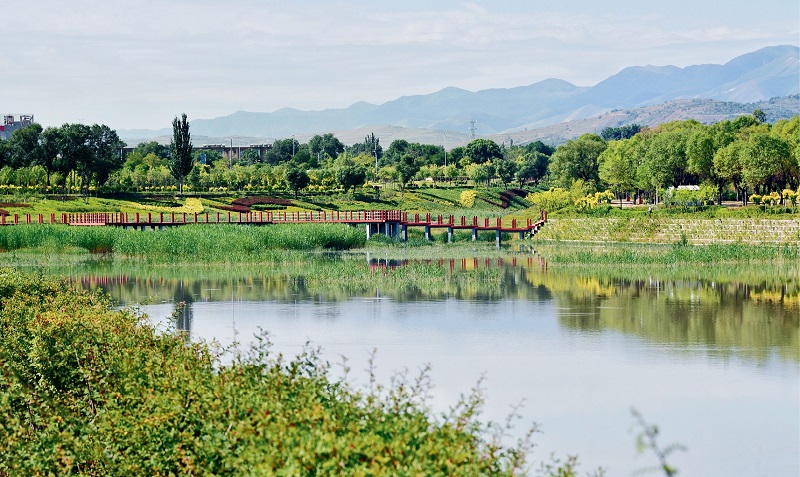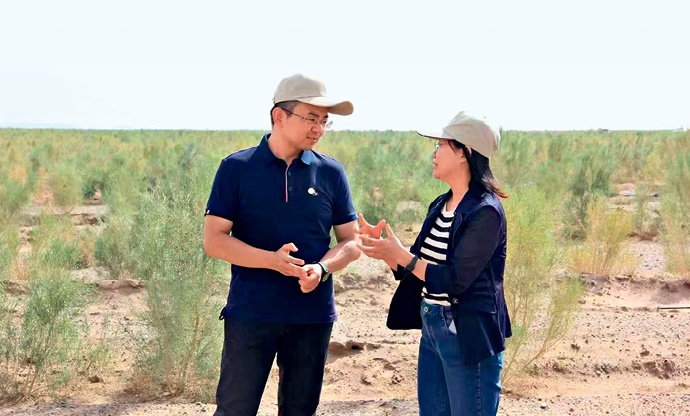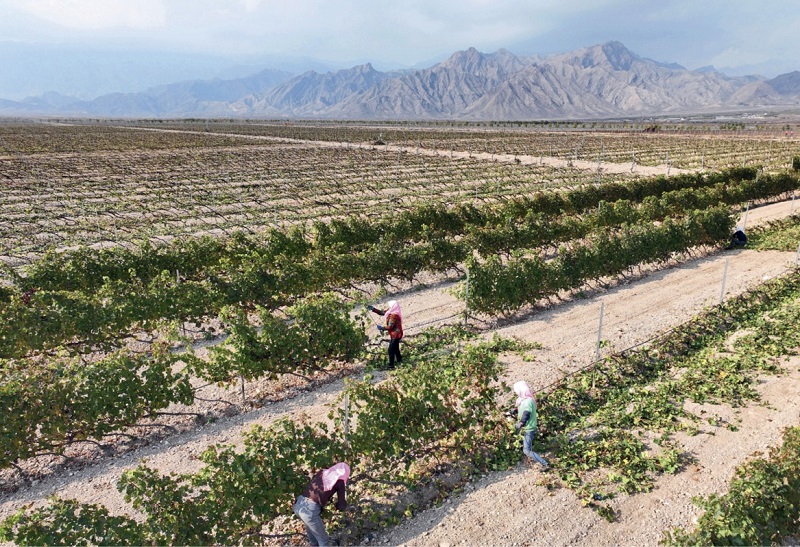As the world grapples with climate change and environmental degradation, green development emerges as both a necessity and an opportunity for sustainable progress.
Over the past decade, China has seen noticeable progress in environmental protection, which also bolstered sustainable economic growth. Meanwhile, China has also pledged to stay committed to delivering a green transition across the board.
In August 2024, a detailed guideline was jointly issued by the Central Committee of the Communist Party of China (CPC) and the State Council of China, reaffirming that a healthy and sound environment is indispensable to people’s wellbeing. It marked the first systematic planning by the central authorities for accelerating the green transition across all areas of economic and social development.
In the report on the work of the government released at this year’s “two sessions,” China’s annual meetings of the top legislature and the top political advisory body, one of the government’s major targets for 2025 is making coordinated efforts to cut carbon emissions, reduce pollution, pursue green development, boost economic growth, and accelerate the green transition in all areas of economic and social development, thus charting the course of green transition.
In interviews with China Today during the “two sessions,” many deputies of the National People’s Congress (NPC) and members of the Chinese People's Political Consultative Conference (CPPCC) National Committee agreed that, with the country’s ongoing progress in ecological conservation, the environment in China has improved tremendously. They acknowledged that high-standard ecological conservation efforts have been critical to high-quality economic and social development.

The Qingshui River in Guyuan City, Ningxia Hui Autonomous Region in August 2023.
Win-Win Outcomes
When speaking to media on March 8, Huang Runqiu, a member of the 14th CPPCC National Committee and minister of ecology and environment, demonstrated two filters from an atmospheric monitoring site in Beijing. One, used in 2015, looked grayish black as it absorbed too much fine particulate matter (PM2.5). The other, used in 2024, generally retained its original white color. The stark contrast illustrated the remarkable progress China has made in environmental protection over the past decade.
Huang Miansong, a member of the 14th CPPCC National Committee and general manager of the smart environmental protection division of Capital Eco-Pro Group, believes that sustained improvement in the environment leads to a thriving environmental protection industry and will improve people’s wellbeing in general.
“I’ve been working on water resource management in my hometown Ningxia Hui Autonomous Region for years and have witnessed the huge transformation firsthand,” Huang said. In an interview during the third session of the 14th CPPCC National Committee, Huang spelled out Ningxia’s progress in ecological conservation by highlighting the initiatives in Guyuan City. Guyuan’s mother river — Qingshui, which literally means “clear water” — was once heavily polluted due to untreated discharge from factories along the banks. Thanks to dedicated control efforts over the past several years, its water quality has been restored and now matches its name. The environmental improvement earned Guyuan a spot on the United Nations’ list of Cities With Nature in 2024. This 2025 government work report states that intensified efforts will be made to improve the system of compensation for ecological conservation and the mechanisms for realizing the market value of ecosystem goods and services. Pilot zones under the Beautiful China Initiative will continue to be developed and more action will be taken to meet people’s expectation for a healthy environment.
Huang told China Today that Guyuan has developed mushroom cultivation, cool weather vegetable growing and other industries by leveraging local ecological conditions, and its produce has reached markets as far as the Guangdong-Hong Kong-Macao Greater Bay Area.
Furthermore, many people who relocated from the over-cultivated land in south Ningxia to the eastern foothills of the Helan Mountains in the north, have successfully developed a thriving wine industry tailored to local conditions. Around 26,700 hectares of once-barren Gobi desert has been converted to green land, especially vineyards. Wine grape crops in this area accounts for nearly 40 percent of the national total.
The wine industry has subsequently become Ningxia’s calling card industry. “To date, thanks to the booming distinctive industries in Ningxia, up to 130,000 relocated people have been lifted out of poverty. This is a win-win outcome where ecological preservation and industrial development go hand in hand,” said Huang.
According to him, by the end of 2024, over 3.4 million people worked in China's ecological protection industry, which generated RMB 2 trillion in revenues in 2024 — an almost fourfold increase compared to more than a decade ago.

In August 2024, Huang Miansong (left) participated in an inspection tour on comprehensive desertification prevention and control, involving key ecological projects such as the national shelterbelt program in northwest, north, and northeast China. Photo courtesy of the interviewee
Tech-Based Transformation
On a cold spring day, the Port of Rizhao in Shandong Province, facing the Yellow Sea, was bustling with operations. At one of its terminals, tens of thousands of metric tons of coal were being quickly loaded onto a cargo vessel, after being conveyed from a stockyard to an automated ship loader through a conveyor system.
This seaport stands as the world’s youngest port with an annual handling capacity of 500 million metric tons, ranking seventh globally. At one time, however, it struggled with the challenges of transitioning from energy-intensive and high-pollution operations to green, low-carbon practices.
This January, Bai Wenhui, a member of the 14th CPPCC National Committee and chairman of Shandong Huaxin Industry Group, came to the Port of Rizhao for an inspection tour.
“My main focus is on its intelligent and green development,” he told China Today, adding that the Port of Rizhao is a hub in the global supply chain for raw materials, energy resources and food. Dry bulk cargo like coal and iron ore accounts for over half of the port’s throughput. Traditionally, dry bulk goods are transported by ships to the port, unloaded by cranes and other equipment, and then delivered to stockyards by trucks. This process leads to environmental issues such as dust pollution and vehicle exhaust emissions.
Bai said to address this issue, green transition and upgrading is critical to the sustainable development of the Port of Rizhao. Over the past several years, the port has adopted tech-based green practices such as intelligent operation, low-carbon energy consumption, and clean transportation and storage. By doing so, remarkable progress has been achieved, added Bai.
On December 27, 2024, the first phase of China’s first intelligent and green demonstration port for dry bulk cargo was put into operation at the Port of Rizhao. It pioneered an intelligent control system which applies to all types of dry bulk goods and covers the entire process. This approach helps not only boost loading and unloading efficiency but also reduce pollution over the operation significantly, providing a viable solution to other ports seeking green and intelligent transition.

Workers prune grapevines in a vineyard at the eastern foothills of the Helan Mountains in Yinchuan City, Ningxia Hui Autonomous Reigion on October 30, 2024.
Chinese Wisdom
Five years ago, China made the commitment to peak carbon emissions by 2030 and reach carbon neutrality by 2060. Since then, China has been making concrete efforts to meet these targets by launching a number of policies and programs at home to tackle climate change and actively engage in international carbon-reduction operations.
At a meeting on the sidelines of COP29 on November 15, 2024, Wen Hua, deputy director-general of the Department of Resource Conservation and Environmental Protection of the National Development and Reform Commission, presented China’s progress in pursuing carbon peak and neutrality: China has developed the world’s largest new energy industry with the most complete industrial chain in this sector; the cost of photovoltaic power production has decreased by 80 percent; in 2023, China’s exports of wind power and PV products helped other countries reduce carbon dioxide emissions by about 810 million metric tons.
Member of the Standing Committee of the CPPCC National Committee and member of the Chinese Academy of Engineering, Shi Bi is confident that the carbon peak and neutrality goals can be realized as scheduled. “China is now at the forefront of green and low carbon development and has contributed considerably to global carbon reduction and green transition. All sectors across society are joining forces and working towards these goals, he said.
Shi also serves as the director of the national engineering laboratory for clean leather manufacturing technologies at Sichuan University. “The laboratory I am working with specializes in treating traditional pollutants,” Shi told China Today, adding that the laboratory has been working on a program for treating water, solid, gaseous and composite pollutants in industrial parks as part of the efforts to bolster green industrial transition. According to China’s 2025 government work report, China will actively and prudently work toward peaking carbon dioxide emissions and achieving carbon neutrality, while introducing new measures such as a carbon labeling and certification, and taking active steps to tackle green trade barriers.
Shi believes carbon reduction actions not only impact the environment but are also instrumental to economic growth. “Particularly, due to different carbon emissions statistics and accounting methods, and scientific evidence in different countries, our exports may face different green trade barriers such as those in the form of compliance requirements,” he said.
To help China’s exports overcome these barriers and enhance its competitiveness in the global market, Shi's team has actively participated in international cooperation on the development of plans and standards for carbon emissions and footprint accounting.
Regarding the focus of future work, Shi said that, with national carbon reduction strategies unfolding, it is critical to establish viable accounting and evaluation mechanisms for carbon emissions and footprints in the leather sector. Meanwhile, his team will intensify efforts on core technology research and accelerate technology application to drive social and economic development.